Welcome to Our Summer Interns!
Meet Grayson and Grace—two of our outstanding summer interns at the Ohio History Connection!
One of my first tasks as a Curator of Natural History was to identify several unknown bird species contained in the Victorian firescreen featured in our Going, Going, Gone? exhibit. This unique item was prepared by “Naturalist, Furrier & Taxidermist” William Thompson of Chester, UK, sometime in the mid- to late 1800s. All but three of the specimens are from the New World.
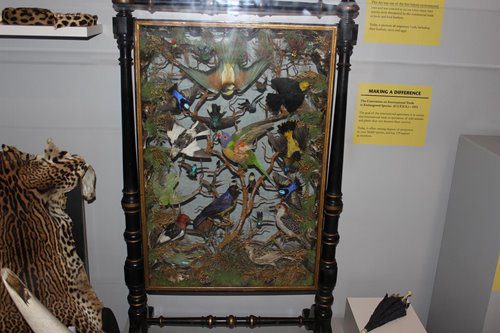 Victorian firescreen on exhibit at OHC
Victorian firescreen on exhibit at OHCTwo things made this task an interesting challenge: the firescreen’s age (the specimens have faded) and its accessibility (a meter behind a plexiglass exhibit barrier). We can’t restore lost color, but fortunately we do have a good zoom lens!
Our Curator Emeritus Bob Glotzhober laid the groundwork for many of the IDs for this item shortly after its acquisition. I confirmed the ID for several birds, including the large turquoise and rust-colored European Bee-eater near the top, the Rainbow Lorikeet from Australia in the center, and the two shining blue Red-legged Honeycreepers to the upper left and lower right of the lorikeet. However, the IDs of many of the hummingbirds–all of which are male specimens–were still unknown.
Although this species’ ridiculously adorable fluffy white “boots” are not visible on this specimen, only two species of hummingbird sport such distinctive racquet-shaped tail feathers–the other being the endangered Marvelous Spatuletail. The Spatuletail’s raquets have a longer and more curved rachis (feather shaft), and it has a violet crown rather than the greenish one we see on the Racket-tail. What other differences do you see?
Another easy ID was this Ruby Topaz.
This specimen’s relatively large size, “long nosed” face and short bill along with its red cap and gold gorget (appearing green at this angle) left no other possibilities. There are two in the firescreen–can you spot them?
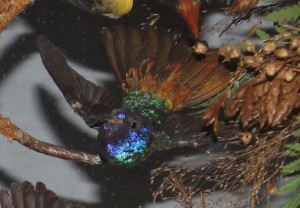 Yes, this is real.
Yes, this is real.…the aptly named Tufted Coquette…
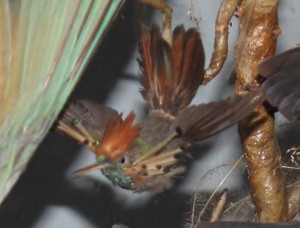 Aptly named, but poorly photographed.
Aptly named, but poorly photographed.…and a stunning Violet-crowned Woodnymph.
 Bee-eaters have no concept of personal space.
Bee-eaters have no concept of personal space.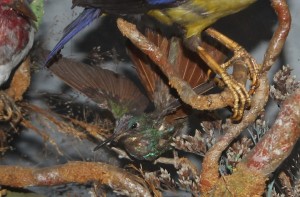 The tanager’s opportune moment was preserved for all time.
The tanager’s opportune moment was preserved for all time.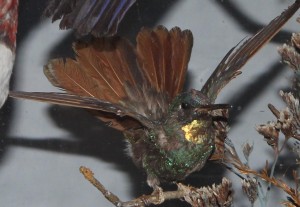 Up to 334 possibilities…
Up to 334 possibilities…
Tyrian is more likely given its abundance and wider distribution, but in any case this hummer is almost certainly in the Metallura genus. (Thanks for your help, Dave!!) What do you think it is?There are four birds in the firescreen that can be found in Ohio. Can you spot them? Let us know in the comments!